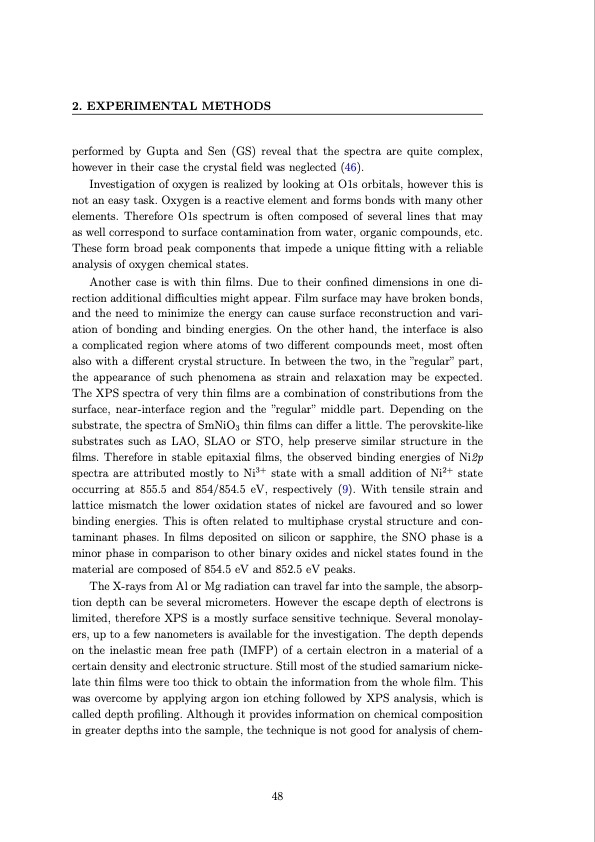
PDF Publication Title:
Text from PDF Page: 069
2. EXPERIMENTAL METHODS performed by Gupta and Sen (GS) reveal that the spectra are quite complex, however in their case the crystal field was neglected (46). Investigation of oxygen is realized by looking at O1s orbitals, however this is not an easy task. Oxygen is a reactive element and forms bonds with many other elements. Therefore O1s spectrum is often composed of several lines that may as well correspond to surface contamination from water, organic compounds, etc. These form broad peak components that impede a unique fitting with a reliable analysis of oxygen chemical states. Another case is with thin films. Due to their confined dimensions in one di- rection additional difficulties might appear. Film surface may have broken bonds, and the need to minimize the energy can cause surface reconstruction and vari- ation of bonding and binding energies. On the other hand, the interface is also a complicated region where atoms of two different compounds meet, most often also with a different crystal structure. In between the two, in the ”regular” part, the appearance of such phenomena as strain and relaxation may be expected. The XPS spectra of very thin films are a combination of constributions from the surface, near-interface region and the ”regular” middle part. Depending on the substrate, the spectra of SmNiO3 thin films can differ a little. The perovskite-like substrates such as LAO, SLAO or STO, help preserve similar structure in the films. Therefore in stable epitaxial films, the observed binding energies of Ni2p spectra are attributed mostly to Ni3+ state with a small addition of Ni2+ state occurring at 855.5 and 854/854.5 eV, respectively (9). With tensile strain and lattice mismatch the lower oxidation states of nickel are favoured and so lower binding energies. This is often related to multiphase crystal structure and con- taminant phases. In films deposited on silicon or sapphire, the SNO phase is a minor phase in comparison to other binary oxides and nickel states found in the material are composed of 854.5 eV and 852.5 eV peaks. The X-rays from Al or Mg radiation can travel far into the sample, the absorp- tion depth can be several micrometers. However the escape depth of electrons is limited, therefore XPS is a mostly surface sensitive technique. Several monolay- ers, up to a few nanometers is available for the investigation. The depth depends on the inelastic mean free path (IMFP) of a certain electron in a material of a certain density and electronic structure. Still most of the studied samarium nicke- late thin films were too thick to obtain the information from the whole film. This was overcome by applying argon ion etching followed by XPS analysis, which is called depth profiling. Although it provides information on chemical composition in greater depths into the sample, the technique is not good for analysis of chem- 48PDF Image | Investigation of metal-insulator transition in magnetron sputtered samarium nickelate thin films

PDF Search Title:
Investigation of metal-insulator transition in magnetron sputtered samarium nickelate thin filmsOriginal File Name Searched:
Bilewska_Investigation_of_metal_insulator_transition_in_magnetron_sputtered_samarium.pdfDIY PDF Search: Google It | Yahoo | Bing
Sulfur Deposition on Carbon Nanofibers using Supercritical CO2 Sulfur Deposition on Carbon Nanofibers using Supercritical CO2. Gamma sulfur also known as mother of pearl sulfur and nacreous sulfur... More Info
CO2 Organic Rankine Cycle Experimenter Platform The supercritical CO2 phase change system is both a heat pump and organic rankine cycle which can be used for those purposes and as a supercritical extractor for advanced subcritical and supercritical extraction technology. Uses include producing nanoparticles, precious metal CO2 extraction, lithium battery recycling, and other applications... More Info
| CONTACT TEL: 608-238-6001 Email: greg@infinityturbine.com | RSS | AMP |